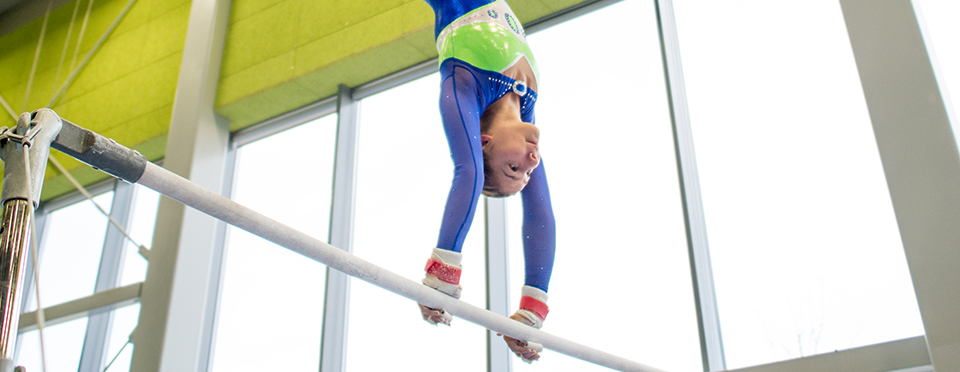
The Importance of Strengthening the Gymnast’s Elbow
Leave a CommentGymnastics offers a unique perspective, even allowing some athletes to see the world upside down!
Very few sports involve supporting the entire body weight with the arms like gymnastics. Due to these special considerations, gymnasts are more prone to certain injuries, such as Osteochondritis Dissecans of the elbow (OCD), and should take care to strengthen the entire arm to decrease injury risk.
What is OCD Elbow?
Osteochondritis Dissecans (OCD) lesions can be found in the elbows of adolescent athletes. The exact cause of OCD in the elbow is unknown, but repetitive microtrauma and decreased blood flow to the subchondral bone are believed to play a role.1 As the underlying bone weakens, a segment of the articular cartilage separates from the subchondral bone, forming a lesion.3 OCD lesions in gymnasts may be caused by repetitive weight bearing on the hands with the elbow in extension.
Presentation of elbow OCD is very vague. A patient can have pain, tenderness and swelling over the lateral aspect of the elbow.3 There may be limitation in how straight the elbow can go and there may be locking or catching if the injury has progressed.2 However, tendinitis of the elbow can have a similar presentation. More often OCD is suspected in specific patient populations including pre-teen and teenage gymnasts as well as young baseball pitchers with elbow pain. Diagnosis is through imaging such as x-ray or MRI.
Treatment for OCD Elbow
Non-operative treatment for elbow OCD consists of rest and sports restriction. For a gymnast that means no weight bearing on arms and no hanging from bars or rings as the latter puts traction stress through the elbow. Muscle strengthening exercises and possibly a short period of immobilization are also usually a part of treatment.3
There are some cases where the lesion is unstable and surgery is the best option. After surgery, physical therapy is performed to reduce pain, swelling and restore range of motion. Resistance strengthening is also incorporated into the rehabilitation after bone healing has occurred, usually around 8 weeks after surgery.3
What Can Athletes Do While Resting Their Elbow?
If a gymnast has been diagnosed with an OCD lesion, they are not allowed to do any weight bearing on the arm, which includes performing skills on the bars. So what can the gymnast do as they allow their elbow to heal? Core strengthening is one option, as core strength is vital to a gymnast and is important during all events. Leg strengthening can also be performed while adhering to the restrictions on the elbow. An overall conditioning program can be designed for the athlete that will incorporate cardio, core strengthening, leg strengthening, shoulder and wrist strengthening, and flexibility stretching. Staying active and in shape is vital to the gymnast during this time to assist in returning to the sport when the elbow restrictions are lifted.
Arm Strengthening for Gymnasts
The elbow is the middle joint of the arm with the shoulder and wrist on either side. While the gymnast’s elbow is healing, it is important to strengthen both of the surrounding joints to provide extra stability for the arm for when return to weight bearing is allowed. Prior to initiating any activities, ensure the gymnasts’ physician has cleared them for return to these exercises.
Shoulder strengthening examples:4
- Resistance band exercises including rows, shoulder extension, diagonals, internal/external rotation
- Sidelying shoulder external rotation
- Tricep extension with band or hand weight
- Bicep curls with band or hand weight
- Prone I, T, Y exercises – exercises can be performed using a swiss ball for added core activation, hand weights can be added for resistance
- Gradual return to weight bearing exercises, like push-ups, planks and handstands, can be added when the athlete is cleared from restrictions
Wrist strengthening examples:
- Wrist curls in both directions with a weight or resistance band
- Gripping exercises for the hands
- Wrist rotation exercises, such as hand weight rolling
- Supination/Pronation with a hand weight
Arm Stretching for Gymnasts
- Wrist flexor stretch
- Wrist extensor stretch
- Cross body shoulder stretch
- Tricep stretch
- Shoulder flexion stretch on foam roller, wall, or mats
- Shoulder circles – lie on your side on the floor and draw a circle on the floor with your top arm by rotating your upper body
- Doorway stretch
Strengthening the Upper Body
Gymnasts have special considerations due to the nature of their sport with weight bearing on the arms. This can lead to injuries of the elbow such as OCD lesions. Strengthening of the entire upper body, including shoulder and wrists, should be incorporated into a conditioning program for both healthy gymnasts and gymnasts recovering from an elbow injury.
For more information, contact an Athletico clinic close to you for a free assessment.
The Athletico blog is an educational resource written by Athletico employees. Athletico bloggers are licensed professionals who abide by the code of ethics outlined by their respective professional associations. The content published in blog posts represents the opinion of the individual author based on their expertise and experience. The content provided in this blog is for informational purposes only, does not constitute medical advice and should not be relied on for making personal health decisions.
References
1. Kajiyama S, Muroi S, Sugaya H, et al. Osteochondritis Dissecans of the Humeral Capitellum in Young Athletes: Comparison Between Baseball Players and Gymnasts. Orthopaedic Journal of Sports Medicine. 2017;5(3):2325967117692513. doi:10.1177/2325967117692513.
2. Kramer, Dennis E. “Elbow pain and injury in young athletes.” Journal of Pediatric Orthopaedics 30 (2010): S7-S12.
3. Van Bergen CJ, van den Ende KI, ten Brinke B, Eygendaal D. Osteochondritis dissecans of the capitellum in adolescents. World Journal of Orthopedics. 2016;7(2):102-108. doi:10.5312/wjo.v7.i2.102.
4. https://usagym.org/pages/home/publications/technique/2009/09/24_shoulder.pdf
